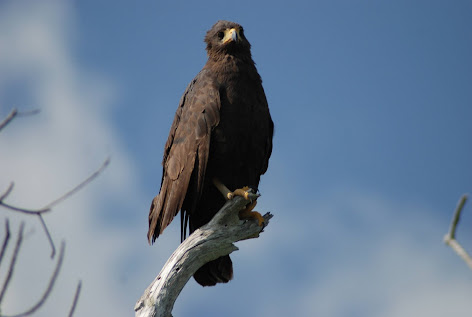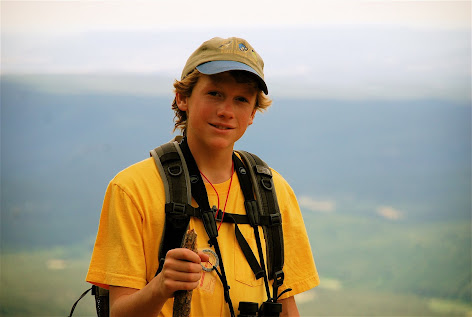 |
| One of my fellow campers observing a pair of Common Terns |
From June 20 to June 25 I think I had the most fun in my life. Wouldn't you say that spending 6 days in coastal Maine, birding, hiking and boating would be pretty fun? I think it would be! Those 6 days I was going to a Audubon camp in Maine called Coastal Maine Bird Studies for Teens located on a beautiful spit of land called Hog Island.
The location of Hog Island is perfect; just inside the Gulf of Maine in Muscongus Bay. The island reminded me a lot of coastal British Columbia because of the rich diversity of life, moss, damp climate and various types of firs. I took one walk on the island and it felt like I was in another world. Winter Wrens were ever-present with their beautiful warble and the dampness and humidity made it feel as if I were in coastal Washington (and coastal B.C.). It took some time to get used to island life and the humidity but I caught on pretty quick to the daily schedule. That was one of the only downsides of the camp: the agenda was very packed every day and there was limited free time. If I had had more free time I would have explored the island more thoroughly.
 |
| A view of Hog Island |
Every morning there was a bird walk at 5:45 AM. I went on it every day but a couple of my fellow campmates decided to be really lazy and sleep in to 6:45 (if you call that sleeping in) to go to breakfast at 7:00. The bird walks were led by people like Kenn Kaufman, Scott Weidensaul, and Greg Budney (the last of which is the curator of the Macaulay Library of Natural Sounds at Cornell). I learned a lot from all of the leaders and am glad I woke up at 5:45 every day! In addition to a bird walk, Sara Morris and Scott led a banding session Wednesday and Thursday in the same time frame as the bird walk. That was the only banding we got to do, although we did have a 3 hour session with Anthony Hill, (a bander from Hadley, MA) and Ken Keffer (who works at the Black Swamp Bird Observatory in Ohio). Unfortunately, it was raining during that period and we had to stay inside because it is unsafe for the birds to be banded in bad weather conditions. We still learned a lot about banding because they taught us how to put the bands on, how to fill out the data sheets and so forth. We even got to measure the band size on some bird specimens and experiment with the data sheets.
The meals at camp were fantastic. There was a professional cook there and he made to best meals! I don't think I've ever been to a camp or gathering with better food. As great as this camp is, it has been closed at certain times in the past 10 years. Last year it was not open because Maine Audubon went under but I think National Audubon has started funding for it -not sure though.
Both the adult group and teen group went on a some sort of field trip every day. For one of the days, we had a tour of the bay surrounding Hog Island and Steve Kress explained the natural and social history of the area. The adults and teens went to a lot of the same places but usually went separately. We went on several "hikes" around the area (I put hikes in parentheses because they were all pretty short in time and distance). We went to a blueberry barren where we saw Vesper Sparrows and a rare Upland Sandpiper! We also went on a hike near Medomak, ME (the town closest to Hog Island).
Without a doubt the best part of the camp was when the teens and teen instructors landed on Eastern Egg Rock and we got to see the nesting colony of Roseate, Common and Artic Terns, Laughing Gulls, Black Guillemots and Atlantic Puffins. Being in a seabird colony is like nothing you've ever experienced and you feel like you are actually a part of it. There is nothing as special as being a foot away from a baby tern or seeing a volunteer hold up a guillemot chick. We even had a volunteer show us a Leach's Storm-Petrel, a bird that is nocturnal and that you rarely see. I am still pondering whether or not to put it on my life list because it was removed (gently) from it's nice cozy burrow, (it certainly blinked a lot when it came out!). As a side note, this was the first time any group of campers were permitted to land on the island so it was pretty special.
 |
| Two of my fellow campmates |
Every night there was a presentation on a certain topic pertaining to birds. One night it was on identifying female warblers, another night it was about migration. I especially liked the presentation Scott Weidensaul did about migration and conservation related to that. Some of the things he said just blew my mind! Such as the fact that Bar-tailed Godwits shrink the size of their entire digestive system by more than 50 percent before they migrate from the Aleutians to New Zealand!! I got Scott to sign my copy of Return to Wild America and I had a couple very interesting conversations with him.




















6 comments:
Just a correction - Maine Audubon is very much alive and well, and still in charge of Hog Island. The camp had been owned and operated by National Audubon for decades, until they turned over the property to Maine Audubon a couple of years ago. Last year, the camps went on a hiatus while Maine Audubon figured out how to fit the camps' operations into its own organization. Hog Island's camps and programs are now being run in partnership between Maine Audubon, and national Audubon's "Project Puffin," which also runs the seabird restoration project on Eastern Egg Rock.
Great blog! I hope you get a chance to come back to Maine again soon.
Thanks for correcting me! I must not have payed attention very well.
Awesome blog..
that camp looks like a ton of fun!!!!!!!!!!!!!!
I was a ton of fun! It was the first camp just about birds that I had been to-what an experience! It is definitely worth the money!
gosh i want to go to that camp!!!!! it seems like a great experience. B)
Post a Comment